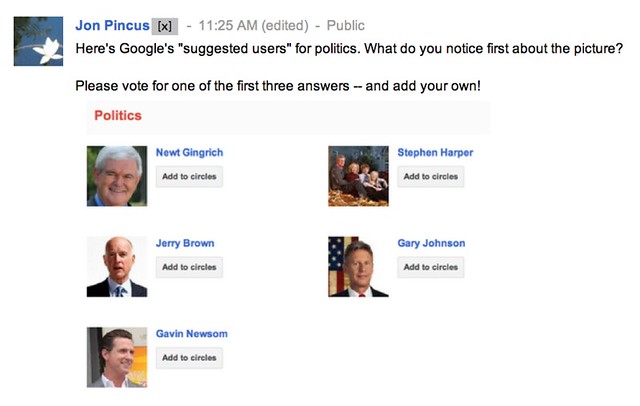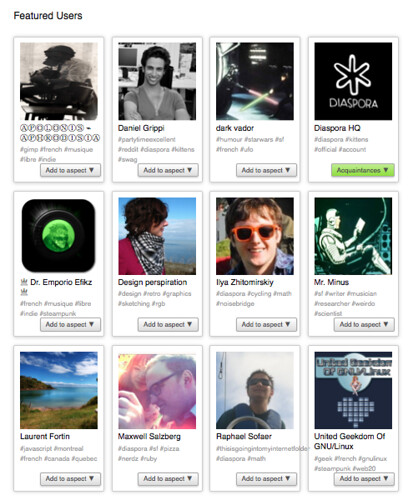Google Plus launched a “suggested users†list yesterday. I’m not on it, and I bet you aren’t either, particularly if you’re an educator — because, well, there aren’t any educators on the list.
— Audrey Watters, Personal Learning Networks and the Google+ “Suggested Users” list
The Google Suggested User List reads like the typical San Francisco Bay Area tech firm’s view of the World: most of the “interesting and famous people” are white, and if they’re black, they’re male rappers or athletes. Hello, Snoop Dog, Chamillionaire, 50 Cent, Dwight Howard, and Floyd Mayweather!
A couple of weeks go, Google community manager Natalie Villalobos asked for feedback on why people’s friends weren’t staying on G+.  One of the things that came up was that it was often very hard for new users to find people the thought would be interesting to follow and engage with. There are a lot of creative ways to approach this, for example Ardith Goodwin’s suggestion of a welcoming committee. Instead, Google+’s decided to take the same approach that worked out spectacularly badly for Twitter two years ago. Will they fare better?
The early returns aren’t encouraging. Dave, Robert, and others immediately criticized the idea of a “suggested users” list and Bradley’s outreach to the Twitter elite. After Bradley responded in Dave’s comments, and then shared more details Saturday morning, Robert asked to be removed from the list. Bradley responded again in Robert’s comments. And the discussion rages on.
Google VP Vic Gundotra’s comment is from Violet Blue’s discussion of the list. As well as Violet Blue, Google also included prominent nymwars critics Jillian C. York, A.V. Flox, and Xeni Jardin. Congrats to all of them, and kudos to Google for giving visibility to dissenting views. Lynette Young of “Women of Google+” is there too, as are ladyada (aka Limor Fried), Elisa Camahort Page of Blogher, and tech journalists like Sarah Perez and Christina Warren. These are all great signals to send from a diversity perspective. Once again, congrats and kudos.
Like Vic says, though, there’s still a ways to go.
Room for improvement
The suggestions in the politics list are probably the most extreme example of the lack of diversity. They’re all from North American. They’re all native English speakers. They represent a fairly narrow range of the political spectrum. [Yes, even in the US, there’s a lot more perspectives than “Northern California Democrats” and “long-shot secular Republican presidential candidates”.] Oh yeah, and they’re all straight white guys too.
Or take the top 22 “picks” — what new users see when they first log in.
- 15 (68%) of them are guys.
- The women* are primarily actresses, singers, or in sports and fitness – no writers, photographers, techies, executives, investors … or educators, of course.
- There aren’t any women of color.
- While there’s some racial diversity with the guys, as Zennie points out the only three blacks are Chamilionaire the Ceo, 50 Cent, and Snoop Dogg. As Shireen Mitchell says in A tale of two challenges
The stereotype that the only way to get diversity is through entertainment or sports is an ongoing saga in the view of Blacks in Tech.
I hope this doesn’t come across as criticizing anybody who is on the list. I respect what they’ve accomplished. There are some truly inspired choices.
But the overall distribution definitely leaves room for improvement.
Just like the real world …
from “Intersectionality and you”
originally in Cognitive evolution and revolution
Emotions run high in debates about “suggested followers” lists. Who’s part of the in crowd? Who’s been left out? Two years after Twitter’s suggested user list, Robert still feels resentful about being left off and watching Pete and Mike soar past him. So does Brooks Bayne of #tcot fame.
It’s unfair.
It’s arbitrary.
It brings back the worst feelings from high school.
So one reason the suggested users list matters is that it will help shape the feel of the community Google’s creating.  As Christina Trapolino points out in What is a community manager, “A real community has to be treated with care and respect. It is a living thing.” Introducing a suggested users list sets up the community so that there’s an in-crowd and an out-crowd.
And the in-crowd favors the big names who at the expense of people who are really engaged with the community. Where are emerging Google+ stars like Daria Musk, Lee Allison, Natalie Villalobos, Ryan Estrada, and Christina Trapolino? Instead we’ve got Tom from MySpace, Richard Branson (who didn’t post at all in August), Google biographer Steven Levy (who only posts twice a week or so) and Google founder Sergey Brin.  The list sets up a power structure that privileges guys, and where the prominent women and blacks are entertainers. Is this what Vic, Bradley, Joseph, and Eric are talking about when they talk about wanting Google+ to mirror how people interact in the “real world”?
Being one of the first people new users at the time a social network starts to explode can be incredibly valuable. Back in 2009, Jason offered $250,000 for a spot on the Twitter suggested users list. And on Google+? In Google just gave me thousands of dollars, maybe more, Marshall Kirkpatrick writes:
We will all now get tens of thousands if not millions of new subscribers to our updates on the network. We will have all the more incentive to keep posting to Plus and to say nice things about it. Those of us who make money doing these sorts of things, as I do when people click my links and view the ads on ReadWriteWeb or consider my consulting services through this site, will probably see a windfall of thousands of dollars. At least. For some new media brands, if Google Plus gets as big as Twitter, it could mean millions of dollars.
A huge windfall being doled out by guys, mostly going to guys, none of it for educators, very little of it for women of color … the media benefitting with incentives not to write about it … hey it is a lot like the real world!
The rich get richer?
Suggested users’ lists typically favor people who are already well-known or well-connected. This list is no exception.  And as Google follows through on its vision of an “identity service” and reputation engine, the people on the list are likely to see their influence increase further.  Their posts are more likely to be +1’ed and reshared. A reshare from them will become more and more valuable.  As Google integrates G+ more deeply into search rankings, their “People Rank” (or whatever Google calls it) will be higher than others. And so on …
Of course, it’s still a pilot.
To be clear (and per my post) the list was derived algorithmically but was also “bootstrapped” and augmented with people known to be popular on other services (yes, including services like broadcast television.) This algorithmic component is why users with many followers but little activity are often not on the list… and conversely users with much activity and fewer followers did make it. I referred to the curated users as “hypotheses” that we’re testing, and mentioned that if they fail to produce great content “Justice will be served” and they’ll be removed over time.
The list is “dynamic.” I know that’s hard to see in a day, but folks will discover that there should be far less concern about who is “on” or “off” the list…. Importantly, by the time we launch Google+, we’ll have implemented the much more targeted means of discovering both interesting users and interesting content that I spoke to in my post
— Bradley, replying to Robert
We shall see.
Meanwhile, back on the nymwars front, several of the people on the suggested users list have names that violate the guidelines. It really highlights the inconsistency of Google’s policies: Dj ASHBA and Chamillionaire the Ceo are ok; Doc Popular, Technogran, and Kaliya IdentityWoman aren’t. 50 Cent and Jennifer 8. Lee are cool; M3 Sweatt isn’t.  Once again, to quote Vic, there’s still a ways to go.
To be continued …
jon
Thanks to Craig Kanally for taking the time to create a copy of the initial list in an easy-to-use format
* Paris Hilton, Britney Spears, Dolly Parton, Jessi June, Erin Williams, Taylor Swift, and Erin Richards.
Check out the previous posts in the series: A Work in Progress, Why it matters, #nymwars!, A tale of two searches, The double bind of oppression, and Anxious masculinity under threat









Leave a Reply